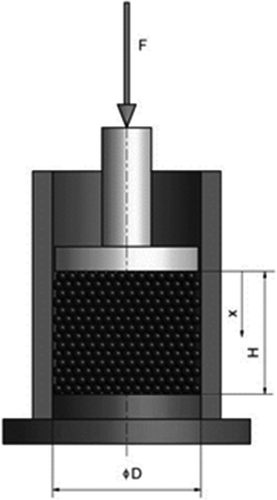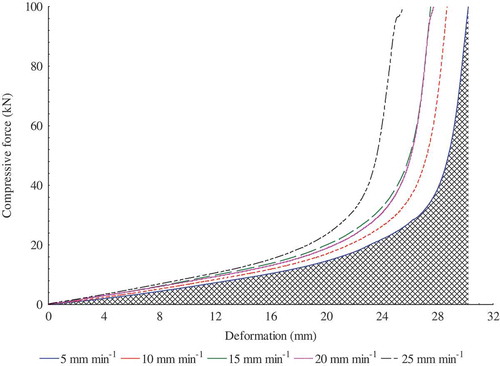ABSTRACT
This study described the compression behaviour of bulk rapeseed using the universal compression testing machine and vessel diameter of 60 mm with a plunger. The pressing factors, namely the heat treatment temperature, speed, and force, were varied between 45 and 105°C, 5 and 25mm min−1 then 40 and 120 kN, respectively. The bulk rapeseed samples were measured at pressing heights between 20 and 100 mm. The parameters determined were maximum deformation (mm), deformation energy (J), oil yield (%), oil point strain (–), oil point force (kN), and oil point energy (J). Clearly, maximum deformation, deformation energy, and oil yield increased with the increase in force and heat treatment temperature, while that of speed showed a downward trend. A plot of the amounts of force and deformation displayed a smooth and serration curve characteristic. The area under the smooth curve behaviour described the compression process where the maximum rapeseed oil was obtained, while the serration pattern represented the ejection of the rapeseed cake through the holes of the pressing vessel as a result of the higher force and speed. The lower and upper oil points of rapeseed were detected at pressing heights 80 mm and 100 mm with corresponding strain values of 0.38 and 0.49 (–). This study provided vital information on rapeseed in axial pressing which can be applied in the industrial technology for optimizing the mechanical screw press oil production.
Introduction
Rapeseed (Brassica napus L.) is a member of the Brassicaceae family grown annually in the temperate regions. In some cultivars, it is known as Canola or Mustard. The bright yellow flowering crop is grown mainly for its seed containing an oil content between 35 and 45% with high-protein animal feed between 17 and 25%. The yields of rapeseed oil range from 940 to 1880 litres per hectare.[Citation1,Citation2] The EU, Canada, the United States, Australia, China, and India are the leading producers. However, Germany, Poland, the United Kingdom, France, Belgium, and Sweden are the main consumers.[Citation3] Rapeseed oil is one of the main sources of biodiesel due to its low sulphur content and low carbon dioxide emission.[Citation4–Citation6] In Europe, rapeseed oil for biofuel accounts for 77% followed by sunflower and soybean oils being 3% and 18%, respectively.[Citation7–Citation9]
In-depth knowledge of the compression behaviour of bulk oilseeds such as rapeseed in linear pressing where a universal testing machine and vessel chamber with a plunger are used is essential for optimizing the oil extraction technology involving a mechanical screw press.[Citation10,Citation11] The mechanical screw press is commonly used in the developing countries due to several advantages including low cost of operation, chemical-free protein-rich cake, and quick adaptation for processing of different oilseeds.[Citation12] However, its efficiency is lower compared to the solvent extraction method which is mostly used in the developed countries.[Citation13,Citation14] Pretreatment of the oilseed such as cleaning, conditioning, decorticating, cracking, flaking, cooking, extruding, and drying to optimal moisture content have been reported to improve the oil recovery efficiency.[Citation15] Thermal treatment has been also proven to be an effective process to increase the oil yield since the process decreases the viscosity of oil which in turn increases the flowability of oil resulting to high oil yield.[Citation15]
The study on the physical and mechanical properties of the bulk oilseeds has been also directed towards the optimization step. The physical properties include the dimensions, length, diameter, geometric mean diameter, surface area, sphericity, volume, 1000-seedweight, bulk and true densities, porosity, terminal velocity, the angle of repose, and coefficient of static friction.[Citation16,Citation17] The mechanical properties, on the other hand, include the maximum deformation, deformation energy, oil point strain, oil point force, and force and deformation curve behaviour in terms of smooth and serration characteristics.[Citation18–Citation21]
In the literature, information on the compression behaviour of bulk rapeseed, i.e., the mechanical properties at different processing factors, is limited. Therefore, the objective of the study was to investigate the effects of heat treatment temperature, force, and speed on the bulk rapeseed under compressing loading.
Materials and methods
Sample
Bulk rapeseed was purchased from the Ceska Skalice, Czech Republic. The moisture content (MC d. b.) (Eq. 1) of the sample was determined using the standard method.[Citation22]
The procedure was that the initial mass of the sample before and after oven drying was weighed using an electronic balance (Kern 440–35, Kern & Sohn GmbH, Balingen, Germany). The test was repeated thrice and results averaged. The moisture content of 5.92 (% d. b.) was evaluated as [Citation23]
where and
represent the mass of rapeseed sample before and after heat treatment (g)
Compression test
The loading test was done with the universal compression device (ZDM 50, Czech Republic).[Citation24] Variations of the heat treatment temperature, force, and speed between 45 and 105°C, 40 and 120 kN then 5 and 25 mm min−Citation1 were examined for bulk rapeseed pressing heights 60 and 100 mm using the vessel diameter of 60 mm (). The equipment (MEMMERT GmbH + Co. KG, Germany) was used for the heat treatment. The parameters determined were maximum deformation (mm), energy (J), oil yield (%), oil point strain (–), oil point force (kN), and oil point energy (J). The test was repeated thrice and statistically analysed employing the STATISTICA 13 software.[Citation25]
Oil point determination
For the detection of the lower and upper oil points,[Citation25] the bulk rapeseed sample was measured at pressing height of 100 mm and then subjected to deformation values of 10.95 mm, 19.87 mm, 29.54 mm, 38.08 mm, and 48.74 mm at a speed of 10 mm min−Citation1.
The deformation values were determined from the bulk rapeseed pressing heights 20, 40, 60, 80, and 100 mm at a speed of 10 mm min−Citation1 and force 100 kN ().
Table 1. Determined amounts with varying pressing height, force, speed, and heat treatment temperature.
Oil yield
The oil yield of bulk rapeseed was determined by [Citation24]
where is the percentage oil yield (%),
is the mass of bulk rapeseed oil (g), and
is the mass of initial height (g).
Deformation energy
The deformation energy of rapeseed was determined by[Citation24]
where E is the deformation energy (J), F is the compressive force (N), and x is the deformation (mm) which was converted to meters during the calculation.
Results and discussion
Deformation, deformation energy and oil yield
shows the results of the compression test of bulk rapeseed at varying pressing heights (mm), forces (kN), speeds (mm min−1), and heat treatment temperatures (°C), respectively. Clearly, for bulk rapeseed pressing heights (mm) at a constant speed of 10 mm min−1 and force 100 kN, maximum deformation, deformation energy, and oil yield ranged from 10.95 ± 0.06 to 48.74 ± 0.09 (mm), 231.08 ± 1.91 to 757.72 ± 2.40 (J), and 17.80 ± 0.46 to 12.88 ± 0.01 (%). For varying forces, maximum deformation, energy, and oil yield ranged from 45.10 ± 0.03 to 50.43 ± 0.09 (mm), 538.99 ± 1.19 to 1045.59 ± 2.33 (J), and 8.10 ± 0.21 to 15.14 ± 0.02 (%). In addition, for the different speeds, maximum deformation, energy, and oil yield ranged from 29.70 ± 0.18 to 27.86 ± 0.13 (mm), 482.79 ± 1.42 to 452.63 ± 9.43 (J), and 16.03 ± 0.17 to 11.18 ± 0.10 (%). Furthermore, for heat treatment temperatures, the above-mentioned measured parameters ranged from 30.05 ± 0.09 to 31.44 ± 1.63 (mm), 503.40 ± 5.57 to 580.45 ± 7.52 (J), and 15.55 ± 0.92 to 22.50 ± 0.54 (%). Generally, oil yield and deformation energy increased with increased temperatures and forces but decreased with increased speeds. The results were statistically significant (p < 0.05) or (Frat > Fcrit) as shown in . Similar results were reported on Jatropha bulk seeds.[Citation10,Citation24] – show the relationships between oil yield (%) and speed, force, and temperature.
Table 2. Correlation analyzes of determined amounts in relation to the factors.
Figure 2. Relationship between oil yield and speed of bulk rapeseed at a speed of 10 mm min−Citation1.
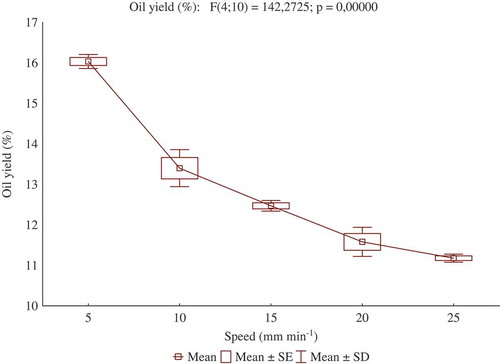
Figure 3. Relationship between oil yield and compressive force of bulk rapeseed at a speed of 10 mm min−Citation1.
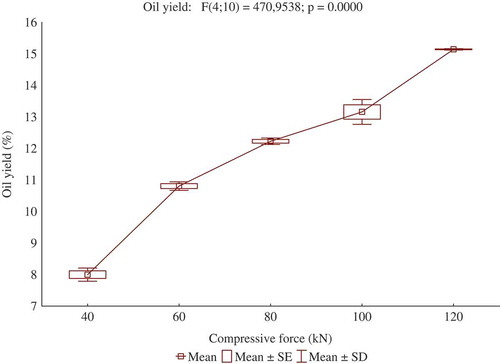
Figure 4. Relationship between oil yield and temperature of bulk rapeseed at a speed of 10 mm min−Citation1.
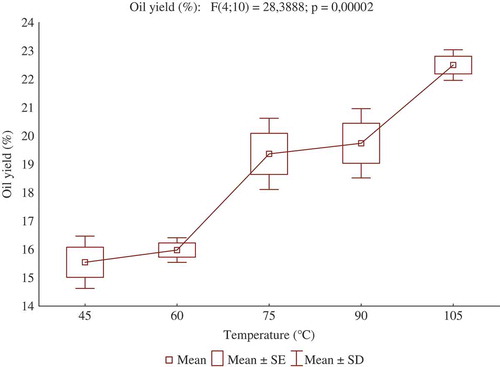
Smooth and serration curve characteristics
The dependency between the amounts of force and deformation of bulk rapeseed at varying speeds is shown in . The area under the curve is denoted as the deformation energy.[Citation26]
shows a smooth and serration characteristic on the force and deformation curve. The smooth curve occurred in the force range of 100‒112 kN at a speed from 5 to 20 mm min−Citation1. On the other hand, the serration effect appeared at a force greater than 112 kN. However, the seration effect was also shown at a force of 100 kN and speed of 25 mm min−1. Clearly, the smooth curve behaviour explains the oil output during compression, while the serration effect is characterized by the ejection of the rapeseed cake through the holes of the pressing vessel which was attributed to the higher compressive force and speed. Therefore, the optimal force and speed in terms of a smooth curve without the serration effect were found at 112 kN and 20 mm min−Citation1, respectively.
Figure 6. Compressive force and deformation characteristics of bulk rapeseed at a speed of 10 mm min−Citation1.
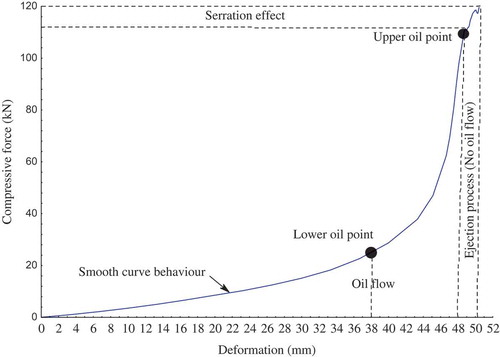
Lower and upper oil points
The oil point is described as the stage at which compression of the bulk material is squeezed for oil to be seen on the surface.[Citation27] The knowledge of the oil point among other variables including the heat treatment temperature, force, and speed are vital for improving the performance of oil extraction process.[Citation28,Citation29] The lower and upper oil points were detected at strain values of 0.38 (–) and 0.49 (–) with their corresponding force and energy of 24.12 ± 0.76 kN and 333.81 ± 0.26 J then 112.15 ± 0.85 kN, and 918.51 ± 0.52 J, respectively ().
Table 3. Oil point amounts of bulk rapeseed at speed 10 mm min−Citation1.
Conclusion
In this study, the compression behaviour of bulk rapeseed was examined at different heat treatment temperatures, forces, and speeds. The results showed that oil yield and deformation energy increased with increased temperatures and forces but decreased with increased speeds. The relationship between the force and deformation demonstrated both the smooth and serration curve behaviours.
The area under the smooth curve behaviour described the oil output, while that of the serration effect was related to the rapeseed cake ejection from the holes of the pressing vessel. The maximum force of 200 kN and speed of 25 mm min−Citation1 contributed to the serration behaviour. The lower and upper oil points were noticed at strain values of 0.4 and 0.5 with corresponding deformation energy of 334 ± 0.3 and 919 ± 0.5, respectively.
Funding
The research was financially supported by the Internal Grant of Faculty of Engineering, CULS Prague [grant number IGA 2016: 31130/1312/3106].
Additional information
Funding
References
- Tickel, J. From the Fryer to the Fuel Tork. the Complete Guide to Using Vegetable Oil as an Alternative Fuel; Green Teach Publishing, Sarasota, FL, USA, 2000.
- Balat, M.; Balat, H. A Critical Review of Biodiesel as a Vehicular Fuel. Energy Conversion Management 2008, 49, 2727–2741.
- Bomba, C.; Mccormickb, K.; Deurwaarderc, E.; Kaberger, T. Biofuels for Transport in Europe: Lessons from Germany and the UK. Energy Policy 2007, 35, 2256–2267.
- Agarwal, A. Biofuels (Alcohols and Biodiesel). Applications as Fuels for Internal Combustion Engines. Progress in Energy and Combustion Science 2007, 33, 233–271.
- Ajanovic, A. Biofuels versus Food Production: Does Biofuels Production Increase Food Prices? Energy 2010, 36, 2070–2076.
- Dworakowska, S.; Bednarz, S.; Bogdal, D. Productioin of Biodiesel from Rapeseed Oil, 1st World Sustainability Forum, Nov 1–30, 2011, pp. 1–6.
- Sunde, K.; Brekke, A.; Birger, S. Environmental Impacts and Costs of Hydrotreated Vegetable Oils, Transesterified Lipids and Woody Btl – A Review. Energies 2011, 4, 845–877.
- Zentkova, I.; Cvengrosova, E. The Utilization of Rapeseed for Biofuels Production in the EU, Visegrad. Bioeconomy and Sustainable Development 2013, 2, 11–14.
- Pereyra-Irujo, G.A.; Izquierdo, N.G.; Covi, M.; Nolasco, S.M.; Quiroz, F.; Aguirrezábal, L. Variability in Sunflower Oil Quality for Biodiesel Production: A Simulation Study. Biomass and Bioenergy 2009, 33, 459–468.
- Karaj, S.; Muller, J. Optimizing Mechanical Oil Extraction of Jatropha Curcas L. Seeds with Respect to Press Capacity, Oil Recovery and Energy Efficiency. Industrial Crops and Products 2011, 34, 1010–1016.
- Pradhan, R.C.; Mishra, S.; Naik, S.N.; Bhatnagar, N.; Vijay, V.K. Oil Expression from Jatropha Seeds Using a Screw Press Expeller. Biosystems Engineering 2011, 109, 156–166.
- Bargale, P.C.; Wulfsohn, D.; Irudayaraj, J.; Ford, R.J.; Sosulski, F.W. Prediction of Oil Expression by Uniaxial Compression Using Time-Varying Oilseed Properties. Agricultural Engineering 2000, 77, 171–181.
- Zheng, Y.; Wiesenborn, D.P.; Tostenson, K.; Kangas, N. Screw Pressing of Whole and Dehulled Flaxseed for Organic Oil. Journal of American Oil Chemistry Society 2003, 80, 1039–1045.
- Deli, S.; Farah Masturah, M.; Tajul Aris, Y.; Wan Nadiah, W.A. The Effects of Physical Parameters of the Screw Press Oil Expeller on Oil Yield from Nigella Sativa L. Seeds. International Food Research 2011, 18, 1367–1373.
- Tunde-Akintunde, T.Y.; Akintunde, B.O.; Igbeka, J.C. Effects of Processing Factors on Yield and Quality of Mechanically Expressed Soybean Oil. Journal of Engineering Technology 2001, 1, 39–45.
- Calisir, S.; Marakoglu, T.; Ogut, H.; Ozturk, O. Physical Properties of Rapeseed (Brassica Napus Oleifera L.). Journal of Food Engineering 2005, 69, 61–66.
- Unal, H.; Sincik, M.; Lzli, N. Comparison of Some Engineering Properties of Rapeseed Cultivars. Industrial Crops and Products 2009, 30, 131–136.
- Herak, D.; Sleger, V.; Mizera, C.; Sedlacek, A. Mechanical Behaviour of Bulk Rapeseeds under Quasi Dynamic Compression Loading. Engineering for Rural Development 2015, 14, 28-32.
- Izli, N.; Unal, H.; Sincik, M. Physical and Mechanical Properties of Rapeseed at Different Moisture Content. International Agrophysics 2009, 23, 137–145.
- Divisova, M.; Herak, D.; Kabutey, A.; Sleger, V.; Sigaliingging, R.; Svatonova, T. Deformation Curve Characteristics of Rapeseeds and Sunflower Seeds under Compression Loading. Scientia Ariculturae Bohemica 2014, 45 (3), 180–186.
- Herak, D.; Kabutey, A.; Sedláček, A.; Gurdil, G. Mechanical Behaviour of Several Layers of Selected Plant Seeds under Compression Loading. Research in Agricultural Engineering 2012, 58, 24–29.
- ISI. Indian Standard Methods for Analysis of Oilseeds, IS: 3579; Indian Standard Institute: New Delhi, 1966.
- Blahovec, J.;. Agromaterials Study Guide; Czech University of Life Sciences: Prague, 2008; 7–8 pp.
- Kabutey, A.; Herák, D.; Chotěborský, R.; Sigalingging, R.; Mizera, Č. Effect of Compression Speed on Energy Requirement and Oil Yield of Jatropha Curcas L. Bulk Seeds under Linear Compression. Biosystems Engineering 2015, 136, 8–13.
- Statsoft., Inc. Tulsa, OK74104, USA, 2010.
- Lysiak, G. Fracture Toughness of Pea: Weibull Analysis. Journal of Food Engineering 2007, 83, 436–443.
- Herak, D.; Kabutey, A.; Hrabe, P. Oil Point Determination of Jatropha Curcas L. Bulk Seeds under Compression Loading. Biosystems Engineering 2013, 116, 470–477.
- Faborade, M.O.; Favier, J.F. Identification and Significance of the Oil-Point in Seed-Oil Expression. Journal of Agricultural Engineering Research 1996, 65, 335–345.
- Sukumaran, C.R.; Singh, B. Compression of a Bed of Rapeseeds:The Oil-Point. Journal of Agricultural Engineering Research 1989, 42 (2), 77–84.

